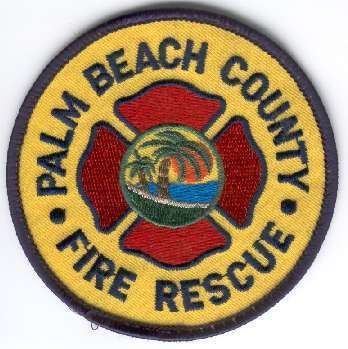Annual calls 120,280 (2013) | Established October 1st 1984 Employees 1,490 | |
 | ||
The Palm Beach County Fire Rescue provides fire protection, emergency medical services, ALS transport and hazardous materials mitigation for unincorporated parts of Palm Beach County, Florida and 18 cities under contract.
Contents
- Combat Operations Structure and Staffing
- Special Ops
- Airport Operations
- Trauma Hawk
- Stations and apparatus
- References
The department is responsible for 1,813 square miles (4,700 km2), providing services to over 746,000 residents throughout the county. Along with the unincorporated areas of the county, PBCFR provides services for Belle Glade, Cloud Lake, Glen Ridge, Haverhill, Juno Beach, Jupiter, Lake Clarke Shores, Lake Park, Lake Worth, Lantana, Manalapan, Pahokee, Palm Springs, Royal Palm Beach, South Bay, South Palm Beach and Wellington.
Combat Operations, Structure and Staffing
The department is made up of 7 battalions which contain anywhere from 3 to 9 fire stations. The battalions are numbered as follows:
These units in addition to responding to calls in their immediate districts are also able to respond to special operations calls throughout Palm Beach County. Each of the 7 Battalions is led by a District Chief who is responsible for overseeing ALL operations, budgets, contracts, etc. in their Battalion. District Chiefs are on a day schedule Monday-Friday but are always on call to respond to large scale incidents as needed. P.B.C.F.R. combat personnel work on a 24 on 48 off schedule, there are 3 shifts A,B, and C. Working under the District Chief in each Battalion are the Battalion Chiefs, who are the highest ranking combat officer and also work the 24/48 schedule. Each shift is led by a Battalion Chief. Each Battalion has 2 combat command level officers one being the Battlaion Chief the other being the District Captain. These 2 command officers work together to insure smooth and safe operation on all incidents, training, and oversight/management duties. The District Captain is primarily responsible in overseeing EMS response and training, while the Battalion Chief is primarily responsible for Fire response and training. Both of these officers function in the command structure as single unit resources and command staff. The Battalion Chief and the District Captain oversee the stations in their respective battalions. Each Station is made up of various units but the normal station includes an Engine or Truck company led by a Captain, and a Rescue unit (ALS Transport) led by a Lieutenant.
The numbering or call signs of P.B.C.F.R. units is as follows; Battalion Chiefs are numbered based on the station they are house in or the battalion HQ station, as are the District Captains. An example of this would be the Battalion Chief of Battalion 3/District 3 would be Battalion 91, while the District Captain of the same battalion would be EMS91. The Engine at station 91 is Engine 91, and the Rescue is Rescue 91. Some stations such as Station 23 have 2 rescues housed in the station. In this case the engine would be "Engine 23", the first rescue would be "Rescue 23" and the second rescue would be "Rescue 223". "Battalion 28" and "EMS 28" would be the battalion 2 Battalion Chief and District Captain.
The District Chiefs or the day chiefs that are the highest-ranking officers in each battalion report to the Division Chief of Operations. The Division Chief of Operations is a day chief that works out of headquarters (405 Pike Rd, West Palm Beach). The Division Chief of Operations (Radio Call Sign OPS2) reports to The Deputy Chief of Operations (Radio Call Sign OPS1). This makes up the combat or 911 response and mitigation structure. P.B.C.F.R. has a Training Division with a Division Chief of Training and multiple Staff Captains of training. The department also has a Rescue Division that is led by a District Chief of Rescue and several staff Captains of Rescue. These areas all working together insure the most well trained, highly skilled response to any emergency and the rapid and safe mitigation of well over a hundred thousand responses each year.
Special Ops
The department has two special operations apparatus. These multipurpose units function as heavy rescues, HazMats, USAR and rescue squads. Locate at stations 19 and 34, they are responsible for hazardous materials incidents, dive rescue, confined space rescue and high angle rescue. They also assist the Sheriff's Office's Explosive Ordnance Disposal Team. The units also function as mobile command center on extended operations.
Airport Operations
The PBCFR is responsible for providing aircraft rescue and firefighting for the Palm Beach International Airport, one the 50 busiest airports in the United States. The station which is located near the center of the airport grounds, is home to 13 pieces of specialized fire fighting equipment.
These apparatus include:
Trauma Hawk
The Palm Beach County Fire Rescue partners with the Palm Beach County Health Care District to operate the Trauma Hawk Aero-Medical Program. The Trauma Hawk program, established in November 1990, replaced the use of Palm Beach County Sheriff's Office helicopters to medevac critically injured patients to area hospitals. At the Trauma Hawk Station, located at the south west corner of Palm Beach International Airport, the department has two Sikorsky S-76C helos. The air ambulances are identically equipped and can carry two patients each and up to four medical attendants if needed. Each helicopter is staffed with a pilot, a registered nurse (RN) and a paramedic. The nurses and paramedics are Palm Beach County Fire Rescue employees while the pilots are Health Care District employees.
Stations and apparatus
Below is a list of all apparatus and their respective fire stations. This list, taken from the PBCFR website, is current as of 25 February 2014.
